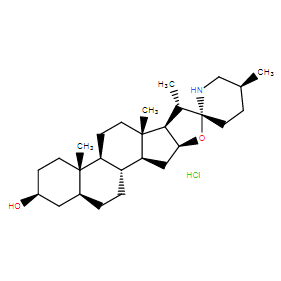| Cas No.: | 6192-62-7 |
| Chemical Name: | 2-[3-[(3R)-3-[[2-chloro-3-(trifluoromethyl)phenyl]methyl-(2,2-diphenylethyl)amino]butoxy]phenyl]acetic acid;hydrochloride |
| SMILES: | C[C@H]1CC[C@@]2([C@H]([C@H]3[C@@H](O2)C[C@@H]4[C@@]3(CC[C@H]5[C@H]4CC[C@@H]6[C@@]5(CC[C@@H](C6)O)C)C)C)NC1.Cl |
| Formula: | C27H46ClNO2 |
| M.Wt: | 452.12 |
| Purity: | >98% |
| Sotrage: | 2 years -20°C Powder, 2 weeks 4°C in DMSO, 6 months -80°C in DMSO |
| Description: | Tomatidine hydrochloride acts as an anti-inflammatory agent by blocking NF-κB and JNK signaling. |
| Target: | p65 JNK |
| In Vitro: | Tomatidine decreases inducible NO synthase and COX-2 expression through suppression of I-κBα phosphorylation, NF-κB nuclear translocation and JNK activation, which in turn inhibits c-jun phosphorylation and Oct-2 expression. Tomatidine, solasodine and diosgenin (40 μM) show 66%, 22% and 41% inhibition of nitrite production, respectively. The iNOS protein is barely detectable in unstimulated cells but markedly increases after LPS treatment, and Tomatidine causes dose-dependent inhibition of LPS-induced iNOS expression. p65 is the major component of NF-κB in LPS-stimulated macrophages, the effect of Tomatidine on p65 DNA-binding activity is determined. In the presence of Tomatidine at 10-40 μM, the binding activity of NF-κB is suppressed in a dose-dependent manner. Tomatidine inhibits the phosphorylation of I-κB, blocks the I-κB production, and furthermore suppresses p65 NF-κB translocation to the nucleus and modulated binding activity[1]. |
| Cell Assay: | RAW 264.7 cells, derived from murine macrophages, are cultured in DMEM supplemented with 10% endotoxin-free, heat-inactivated fetal calf serum, Penicillin (100 units/mL), and Streptomycin (100 μg/mL) in a 5% CO2 atmosphere at 37 °C in a humidified incubator. For all assay, cell is plated at 2×105 cells/cm2 in culture dishes or plates. Treatment with vehicle (0.1% DMSO or 0.1% ethanol), test compounds and/or LPS is carried out under serum-free conditions[1]. |
| References: | [1]. Chiu FL, et al. Tomatidine inhibits iNOS and COX-2 through suppression of NF-kappaB and JNK pathways in LPS-stimulated mouse macrophages. FEBS Lett. 2008 Jul 9;582(16):2407-12. |

 To enhance service speed and avoid tariff delays, we've opened a US warehouse. All US orders ship directly from our US facility.
To enhance service speed and avoid tariff delays, we've opened a US warehouse. All US orders ship directly from our US facility.




















